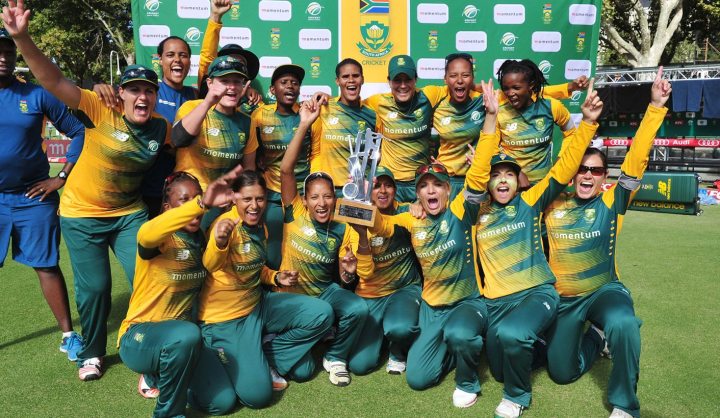Sport
Analysis: Why women’s cricket at the 2022 Commonwealth Games could be a significant step into new markets

The ICC have announced that they will push for the women’s game to be included at the 2022 Commonwealth Games. This move, and the continued push for cricket’s inclusion at the Olympics, presents an interesting prospect for the future of the women’s game. By ANTOINETTE MULLER.
The International Cricket Council (ICC) has made another move which points to the governing body finally acknowledging that in order to remain relevant and sustainable in both the men and women’s games, it needs to continue tapping into new markets.
The ICC held its annual conference in Edinburgh over the weekend, and confirmed plans to make a bid for women’s cricket to be included in the Commonwealth Games. Following a presentation by the Commonwealth Games Federation, the ICC board agreed to apply for a women’s competition at the Durban Games, to be held in 2022.
Cricket has featured at the Games before, with South Africa winning the 50-over gold medal at the 1998 event in Malaysia. Cricket also features at the Asian Games, and the last two editions have included both the men and women’s competitions – with Sri Lanka winning gold in the men’s tournament, and Pakistan winning gold in the women’s version.
The foray into the Commonwealth Games will reignite the discussion in the possibility of including cricket in the Olympics. With the governing body itself admitting that it would be pursing this route later this year, the inclusion of women’s cricket in the Games could be significant step forward in professionalising the sport.
While most of cricket’s full members offers some sort of compensation for its female cricketers these days, the money is often significantly less than what their male counterparts earn. The establishment of the Women’s Big Bash League in Australia and the English Super League has added to those revenue opportunities, but women’s cricket is still very much the black sheep when it comes to investment.
However, having it included in the Commonwealth Games, and eventually the Olympics, could be a significant step forward for creating more earning opportunities for female athletes, as countries who might not have a traditional cricket-playing background realise the opportunities for medals.
For certain countries, investment into professional sporting structures is often heavily based on their potential to earn medals. China and the USA are two good examples. With Rugby Sevens now being part of the Olympics, both countries have poured significant investment into their men and women’s plans.
When the International Olympic Committee (IOC) decided to reintroduce rugby to the Games in 2009, China reacted immediately and geared focus at universities towards Sevens, despite the fact that XVs had been played in the country rather for centuries. In 2010, it set up teams in each one of the country’s provinces which focused only on rugby. China did not qualify for the Olympics, but have already started making plans to improve.
China aims to train one million rugby players in the next ten years in a bid to prepare teams for the next Olympics, in a partnership between Jack Ma, chairman of the online international trading empire Alibaba, and World Rugby.
Similar growth is happening in the United States and, most notably, women will be the driving force in the sport’s expansion.
Earlier this year, World Sevens Series sponsor HSBC teamed up with strategic planning consultancy The Futures Company to produce a report “The Future of Rugby” to envision what the sport would look like over the next team years.
The report says that the Olympics will be the “launch pad” for rugby’s growth, and predicts that women will make up as much as 40 per cent of global participation. Rugby is booming across the globe and the report adds:
“The incredible thing about rugby’s growth in the last three years is that almost half of it has been fuelled by increases in women’s participation. The number of female players has gone from 200,000 to 1.7 million in that time, with sevens acting as the perfect catalyst. It has been nothing short of explosive and we believe this will continue.”
While China and the USA are not Commonwealth countries, the continued push for cricket’s inclusion in the Olympics, starting with the women’s version at the 2022 Games could provide similar impetus.
China, though, poses a far more interesting prospect. For decades since their return to the Olympics in 1980, China’s sporting system has been incredibly successful. They topped the medals table when they hosted the Games in 2008 and only ended up slightly behind the USA during London 2012.
But the unforgiving and demanding regimes that children, often as young as six, are falling into is becoming increasingly less attractive for a new generation of parents. The sporting schools in China have decreased from 3,687 in 1990 to just over 2,180 currently.
The school’s party committee secretary, Huang Qin, explained in an interview with Reuters recently:
“Parents are less willing now to send their child to sports schools if they perform fairly well in exams…The source of students for sports schools has shrunk as society placed more importance on cultural education.”
These concerns started in 2008 already, as stories of retiring athletes with no education to fall back on started to emerge. In 2010, the country responded with a new policy titled document 23 which ordered traditional sporting schools to support retired athletes and improve teaching standards. Some sporting schools have also relaxed their requirements for sporting school students to study, live and train on campus. Other schools have either started to require students to take an academic entrance exams.
This holistic approach might be new to China, but other sporting codes, including cricket, have long realised that it is vital for the overall development of well-rounded young people. The change could provide a unique opportunity for the women – and men’s game – to make their global mark.
But where there is growth, there will be the need for mentors, and just as China has pushed rugby at its universities, it’s not unthinkable that it would do something similar with cricket, especially if China continues to view higher education and sporting success as mutually exclusive. The need for coaches and talented skill shares could provide the opportunity for young female cricket players to go study overseas on scholarships, playing for universities – all while lending a hand with coaching and basic cricket skills (a largely foreign concept to this market). It could also see the creation of a league structure, offering women more earning opportunities.
That potential watershed moment is still more than eight years away, though, and while it could revolutionise the sport in new markets, one would hope that the governing bodies come up with sustainable solutions of their own for the women’s game long before then. DM
Photo: The team of South Africa celebrate their Series win during West Indies Women tour of South Africa, 3rd T20 International at Newlands Cricket Ground, Cape Town on 9 March 2016 © Chris Ricco/BackpagePix




















 Become an Insider
Become an Insider